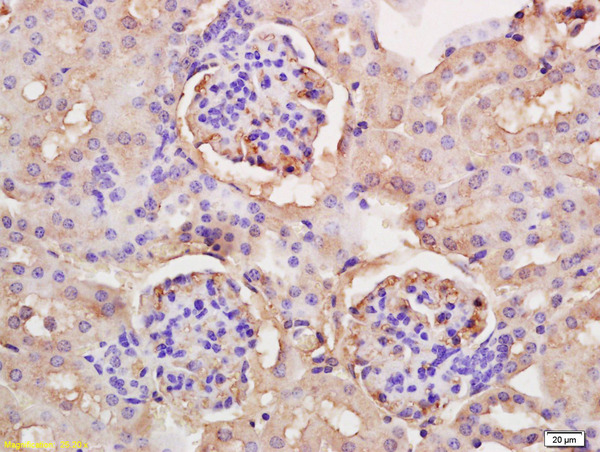
IHC-P analysis of rat heart tissue using GTX31921 PGC1 alpha antibody. Working concentration : 5 microg/ml
PGC1 alpha antibody
GTX31921
ApplicationsImmunoFluorescence, Western Blot, ELISA, ImmunoCytoChemistry, ImmunoHistoChemistry, ImmunoHistoChemistry Paraffin
Product group Antibodies
ReactivityHuman, Mouse, Rat
TargetPPARGC1A
Overview
- SupplierGeneTex
- Product NamePGC1 alpha antibody
- Delivery Days Customer9
- Application Supplier NoteWB: 2 microg/mL. ICC/IF: 20 microg/mL. IHC-P: 1-2 microg/mL. *Optimal dilutions/concentrations should be determined by the researcher.Not tested in other applications.
- ApplicationsImmunoFluorescence, Western Blot, ELISA, ImmunoCytoChemistry, ImmunoHistoChemistry, ImmunoHistoChemistry Paraffin
- CertificationResearch Use Only
- ClonalityPolyclonal
- Concentration1 mg/ml
- ConjugateUnconjugated
- Gene ID10891
- Target namePPARGC1A
- Target descriptionPPARG coactivator 1 alpha
- Target synonymsLEM6, PGC-1(alpha), PGC-1alpha, PGC-1v, PGC1, PGC1A, PPARGC1, peroxisome proliferator-activated receptor gamma coactivator 1-alpha, L-PGC-1alpha, PGC-1-alpha, PPAR gamma coactivator variant form, PPARAGCIalpha, PPARGC-1-alpha, PPARgamma coactivator 1alpha, ligand effect modulator-6
- HostRabbit
- IsotypeIgG
- Protein IDQ9UBK2
- Protein NamePeroxisome proliferator-activated receptor gamma coactivator 1-alpha
- Scientific DescriptionThe protein encoded by this gene is a transcriptional coactivator that regulates the genes involved in energy metabolism. This protein interacts with PPARgamma, which permits the interaction of this protein with multiple transcription factors. This protein can interact with, and regulate the activities of, cAMP response element binding protein (CREB) and nuclear respiratory factors (NRFs). It provides a direct link between external physiological stimuli and the regulation of mitochondrial biogenesis, and is a major factor that regulates muscle fiber type determination. This protein may be also involved in controlling blood pressure, regulating cellular cholesterol homoeostasis, and the development of obesity. [provided by RefSeq, Jul 2008]
- ReactivityHuman, Mouse, Rat
- Storage Instruction-20°C or -80°C,2°C to 8°C
- UNSPSC12352203
References
- Yang YL, Wang PW, Wang FS, et al. miR-29a Modulates GSK3β/SIRT1-Linked Mitochondrial Proteostatic Stress to Ameliorate Mouse Non-Alcoholic Steatohepatitis. Int J Mol Sci. 2020,21(18). doi: 10.3390/ijms21186884Read this paper
- Colitti M, Montanari T. Brain-derived neurotrophic factor modulates mitochondrial dynamics and thermogenic phenotype on 3T3-L1 adipocytes. Tissue Cell. 2020,66:101388. doi: 10.1016/j.tice.2020.101388Read this paper












